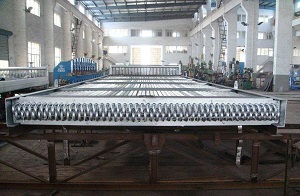Industrial Air Coolers: Advanced Heat Transfer Solutions
What is an Air Cooler?
An air cooler, technically known as an Air-Cooled Heat Exchanger (ACHE), is an engineered thermal management system designed to transfer heat from process fluids to ambient air. Unlike water-cooled systems, air coolers utilize atmospheric air as the cooling medium, making them ideal for applications where water scarcity, environmental regulations, or operational constraints limit traditional cooling methods.
These systems are fundamental in industrial processes requiring precise temperature control of liquids and gases. With configurations ranging from compact modular units to massive multi-fan installations, air coolers serve critical functions in:
- Process fluid temperature regulation (40-400°C range)
- Gas compression cooling in pipeline operations
- Condensation of process vapors and steam
- Hydraulic and lubrication oil cooling
Core Components of Industrial Air Coolers
Heat Transfer Tubes
The primary thermal exchange surface where process fluids circulate. Constructed from corrosion-resistant materials (carbon steel, stainless steel 304/316, copper-nickel alloys) with diameters ranging from 15-50mm. Special internal enhancements like rifling or turbulators increase turbulence, boosting heat transfer efficiency by 15-30%.
Extended Surface Fins
Precision-engineered aluminum or copper fins bonded to tubes to amplify surface area 8-20 times. Key configurations include:
- L-footed embedded fins (most common)
- Extruded bi-metallic fins
- Welded stainless steel fins
Fin densities range from 150-500 fins/meter depending on air quality and thermal requirements.
High-Efficiency Fans
Axial or centrifugal fans with diameters from 0.5-6 meters, generating airflows up to 500,000 m³/h. Modern designs feature:
- Variable frequency drives (VFD) for 30-100% flow control
- Auto-reverse systems for self-cleaning
- Low-noise aerodynamic blades
Header Distribution Systems
Pressure vessels distributing fluid through tube bundles with:
- Removable cover plates for maintenance access
- Multi-pass configurations for optimal ΔT
- ASME Section VIII Division 1 compliance
Designed for pressures up to 6.5 MPa and temperatures to 450°C.
Thermodynamic Process of Heat Exchange
Hot Fluid Ingress: Process fluid enters tube bundles at 60-400°C through inlet headers, with flow rates optimized to maintain turbulent flow (Re > 4000) for maximum
heat transfer efficiency.
Conductive Transfer: Heat migrates through tube walls to externally mounted fins, with thermal conductivity ranging from 45 W/m·K (carbon steel) to 400 W/m·K (copper).
Convective Cooling: Forced air (2-6 m/s velocity) flows perpendicularly across finned tubes, absorbing thermal energy through boundary layer disruption. Fin efficiency typically reaches 85-95% in optimal designs.
Temperature Reduction: Process fluids experience approach temperatures within 5-15°C of ambient air, with cooling capacities up to 50 MW in large industrial units.
Cooled Fluid Egress: Temperature-regulated fluid exits through outlet headers, ready for process reintegration or storage.
Engineering Advantages of Air Cooling Systems
Space Optimization
Vertical and V-frame configurations achieve 40-60% footprint reduction versus water-cooled alternatives. Modular designs enable rooftop or compact pad installations where space is constrained.
Reduced Operational Costs
Eliminates 90% of water consumption and associated treatment chemicals. Fan power requirements are typically 0.5-2.5 kW per MW of cooling capacity - 30-50% less than equivalent pumping systems.
Environmental Compliance
Zero thermal discharge to waterways and no chemical contamination risk. Noise levels controlled to 80-85 dBA at 1 meter through aerodynamic fan designs and acoustic enclosures.
Operational Versatility
Functions effectively from -40°C arctic conditions to +55°C desert environments. Special coatings protect against coastal salt spray and chemical atmospheres.
Industrial Application Spectrum
Air coolers have become indispensable across multiple sectors due to their adaptability and efficiency:
Energy Generation:
- Turbine lube oil cooling in power plants (10-15°C above ambient)
- Transformer cooling in substations
- Solar thermal plant thermal oil cooling
Hydrocarbon Processing:
- Crude oil cooling from 150°C to 60°C pre-storage
- Refinery overhead condensers handling 200-300°C vapors
- Compressed natural gas (CNG) cooling to 40-50°C
Chemical Manufacturing:
- Polymer pellet cooling from extrusion processes
- Reactor effluent quenching
- Solvent vapor condensation
HVAC & Infrastructure:
- Data center hydraulic cooling systems
- District heating network return cooling
- Tunnel ventilation heat rejection
These systems prove particularly valuable where water resources are scarce or environmental regulations prohibit effluent discharge, offering a sustainable alternative with minimal ecological impact.

Finned Tube Air Cooler - Optimized for maximum thermal transfer in compact footprint
Technical Specifications & Performance Data
Thermal Capacity: 50 kW - 50 MW
Temperature Range: -50°C to +450°C
Pressure Rating: Vacuum to 6.5 MPa
Airflow: 5,000 - 500,000 m³/h
Heat Transfer Coefficient: 50-150 W/m²·K
Approach Temperature: 5-15°C above ambient
Materials: CS, SS304/316, CuNi 90/10, Titanium
Design Standards: API 661, ISO 13706, ASME
Performance Optimization Features
- Variable Pitch Fans: Adjust blade angle for seasonal efficiency
- Louver Control Systems: Regulate airflow during low-load conditions
- Corrosion Protection: Hot-dip galvanizing or specialized coatings
- Frost Prevention: Recirculation systems for sub-zero operation


